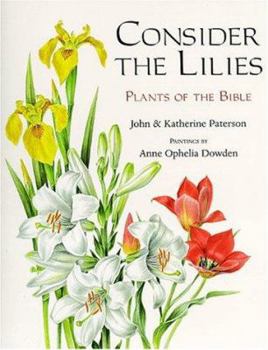Consider the Lilies: Plants of the Bible
Select Format
Select Condition 
Book Overview
An exploration of the symbolic significance of the numerous trees, plants, flowers, and fruits of the Bible, illustrated with an array of exquisite paintings by Anne Ophelia Dowden, one of the world's... This description may be from another edition of this product.
Format:Paperback
Language:English
ISBN:039588828X
ISBN13:9780395888285
Release Date:January 1998
Publisher:Clarion Books
Length:96 Pages
Weight:0.53 lbs.
Dimensions:0.5" x 7.0" x 9.0"
Age Range:9 to 12 years
Grade Range:Grades 4 to 7
Customer Reviews
2 ratings
Gorgeous Illustrations + Interest
Published by MyKidsMommy8 , 14 days ago
I bought this for some supplemental historical content. Although the focus is the Bible plants, it's been useful to point out the relevance in today's world that we hear so much about. The places in the Bible are modern day Iraq or Iran or Egypt, etc. So showing students what grew historically there and how it was used by those cultures VS how it us used today- has been fun. It gave a social studies element I wasn't expecting. The illustrations as noted by the other review are less cartoon more realism allowing young children to compare to plants outside right now. I highly recommend this book just for botony, history, social studies, and geography etc. It's not peachy. I would use it even if I were not a Christian. I use similar books with a background in Hindu, Buddhism, etc. Finding common ground is always a positive thing!
Fabulous pictures & relevant information
Published by Thriftbooks.com User , 17 years ago
This book has great drawings that look more like photographs of some plants mentioned in the Bible. It is by no means an exhaustive reference. It quotes the biblical background first and then tells about the plant. It includes how it was used, how common it was, what it looked like and how it grew, etc. For example, it tells the wheat/weeds/mustard seed story from the NT parable, then has a full-page painting of wheat, mustard and darnel (the weed) next to each other, gives the latin name for each, and then writes this: 'For more than 8,000 years, various species of wheat have been cultivated in Asia Minor, and in Bible times, wheat was the main field crop. Since it was grown without irrigation, it suffered seriously in years of drought, and disastrous famines often resulted. The 'weeds' referred to here were probably darnel grass or 'tares,' a hardy grass that grows only in grain fields. Before its seed heads form, it looks very much like wheat, and its seeds are about the same size and shape as wheat seeds, so they easily become mixed with the threshed grain. they not only adulterate the wheat but also can carry a poisonous fungus that causes blindness or even death. The mustard seed in this passage is probably that of the common black mustard. In powdered form, these seeds have since earliest times been used for flavoring and medicine, but the Hebrews valued them chiefly for the oil they produce. In northern gardens, mustard is usually no more than three or four feet tall, but in hot countries it sometimes grows ten to fifteen feet high, with a stalk as thick as a man's arm." I think it's a great book - great info, biblical relevance and great pictures (they're all like the cover basically).





